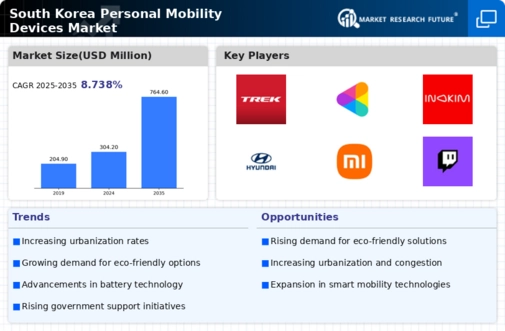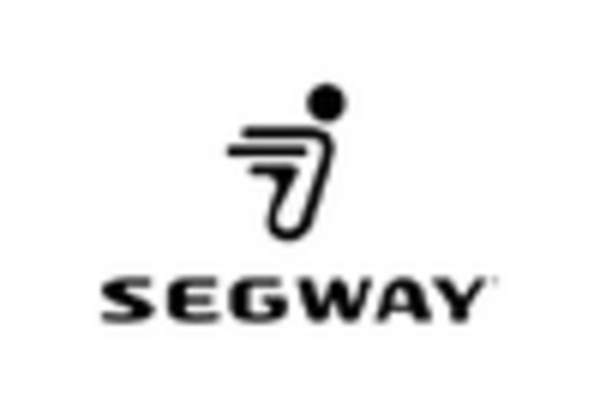Urbanization and Population Density
The rapid urbanization in South Korea is a pivotal driver for the personal mobility-devices market. As cities expand and populations concentrate, the demand for efficient transportation solutions intensifies. In urban areas, where traffic congestion is prevalent, personal mobility devices offer a practical alternative to traditional vehicles. The increasing population density, particularly in metropolitan regions like Seoul, necessitates innovative mobility solutions that can navigate crowded streets. According to recent data, urban areas in South Korea are projected to house over 80% of the population by 2025, further propelling the need for personal mobility devices. This trend indicates a shift towards more compact and efficient modes of transport, which aligns with the evolving preferences of consumers seeking convenience and flexibility in their daily commutes.
Technological Integration and Smart Features
The integration of advanced technologies into personal mobility devices is transforming the market landscape in South Korea. Features such as GPS navigation, smartphone connectivity, and real-time tracking are becoming standard in new models. This technological evolution not only enhances user experience but also increases safety and efficiency. The personal mobility-devices market is witnessing a surge in demand for smart devices that can seamlessly integrate with urban infrastructure. For instance, the introduction of smart parking solutions and charging stations for electric scooters and bikes is indicative of this trend. As of 2025, it is estimated that over 60% of new personal mobility devices will incorporate smart technology, reflecting a significant shift towards tech-savvy solutions that cater to the needs of modern consumers.
Changing Consumer Preferences and Lifestyle Shifts
The evolving lifestyle of South Korean consumers is a significant driver of the personal mobility-devices market. As urban dwellers increasingly prioritize convenience and flexibility, there is a noticeable shift towards personal mobility solutions that cater to these needs. The rise of the gig economy and remote work has led to changes in commuting patterns, with many individuals seeking alternatives to traditional public transport. Personal mobility devices, such as e-scooters and e-bikes, offer a practical solution for short trips and last-mile connectivity. Market Research Future indicates that approximately 40% of consumers in South Korea are considering purchasing a personal mobility device in the next year, reflecting a growing acceptance of these alternatives. This trend suggests that the personal mobility-devices market is well-positioned to capitalize on changing consumer behaviors and preferences.
Environmental Awareness and Eco-Friendly Solutions
Growing environmental consciousness among South Korean consumers is driving the personal mobility-devices market towards more sustainable options. As awareness of climate change and pollution increases, individuals are seeking eco-friendly alternatives to traditional transportation methods. Electric scooters and bicycles, which produce zero emissions, are gaining popularity as viable options for short-distance travel. The South Korean government has also been promoting green initiatives, encouraging the adoption of electric mobility devices. Recent statistics indicate that sales of electric personal mobility devices have increased by 25% in the past year, highlighting a shift in consumer preferences towards sustainable solutions. This trend suggests that the personal mobility-devices market is likely to continue evolving in response to environmental concerns, with manufacturers focusing on developing greener technologies.
Government Initiatives and Infrastructure Development
Government support plays a crucial role in shaping the personal mobility-devices market in South Korea. Initiatives aimed at enhancing urban mobility and reducing traffic congestion are being implemented, which include the development of dedicated lanes for bicycles and electric scooters. Such infrastructure improvements not only facilitate the use of personal mobility devices but also promote their adoption among the general public. The South Korean government has allocated substantial funding for the expansion of cycling paths and charging stations, which is expected to boost the market significantly. By 2025, it is anticipated that government investments in mobility infrastructure will exceed $500 million, further solidifying the personal mobility-devices market as a key component of urban transportation strategies.

















Leave a Comment